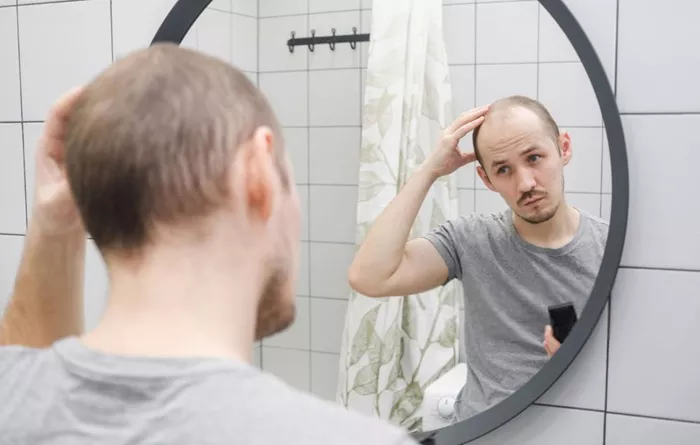Hair loss is a common concern that affects millions of people worldwide, leading many to wonder whether it’s possible for hair to grow back naturally after balding. The answer isn’t straightforward, as it depends on the underlying cause of hair loss, genetics, lifestyle factors, and overall health. While some forms of hair thinning can be reversed naturally, others may require medical intervention. Understanding the mechanisms behind hair loss and the body’s ability to regenerate hair follicles is key to determining whether natural regrowth is possible.
Understanding the Causes of Hair Loss
Before exploring whether hair can grow back, it’s essential to understand why hair loss occurs in the first place. Several factors contribute to balding, including:
Androgenetic Alopecia (Male and Female Pattern Baldness)
This is the most common form of hair loss, affecting both men and women. It is primarily genetic and linked to dihydrotestosterone (DHT), a hormone that shrinks hair follicles over time, leading to thinner and shorter hair until growth eventually stops.
Telogen Effluvium (Temporary Hair Shedding)
This condition occurs when a significant number of hair follicles enter the resting phase (telogen) prematurely, often due to stress, illness, hormonal changes, or nutritional deficiencies. Unlike androgenetic alopecia, this type of hair loss is usually reversible once the underlying trigger is addressed.
Alopecia Areata (Autoimmune Hair Loss)
An autoimmune disorder where the body attacks its own hair follicles, leading to patchy hair loss. In some cases, hair may regrow spontaneously, but the condition can be unpredictable.
Scarring Alopecia (Permanent Hair Loss)
Certain conditions, such as lichen planopilaris or folliculitis decalvans, destroy hair follicles and replace them with scar tissue, making regrowth impossible without medical intervention.
Nutritional Deficiencies and Poor Scalp Health
Lack of essential vitamins (like biotin, iron, and vitamin D), poor blood circulation, and scalp conditions like dandruff or fungal infections can contribute to hair thinning.
Can Hair Regrow Naturally After Balding?
The possibility of hair regrowth depends largely on the cause of balding.
Reversible Hair Loss (Telogen Effluvium, Nutritional Deficiencies, Stress-Induced Shedding)
In cases where hair loss is triggered by temporary factors, hair can often grow back naturally once the root cause is resolved. For example:
Stress Reduction: Chronic stress elevates cortisol levels, disrupting the hair growth cycle. Managing stress through relaxation techniques, exercise, and proper sleep can help restore normal hair growth.
Balanced Diet: Consuming protein, iron, zinc, and vitamins A, D, and E supports follicle health. Foods like eggs, spinach, nuts, and fatty fish promote hair strength and growth.
Scalp Care: Keeping the scalp clean, massaging to improve blood flow, and using natural oils (like rosemary or peppermint oil) may stimulate dormant follicles.
Androgenetic Alopecia (Genetic Hair Loss)
Unfortunately, once hair follicles miniaturize due to DHT sensitivity, they rarely recover fully without treatment. However, some natural approaches may slow progression and improve hair density:
- DHT Blockers: Saw palmetto, pumpkin seed oil, and green tea extract may reduce DHT levels.
- Microneedling: Studies suggest that dermarolling can stimulate collagen production and awaken dormant follicles.
- Essential Oils: Rosemary oil has shown promise in improving hair thickness similarly to minoxidil (Rogaine).
Alopecia Areata (Autoimmune-Related Hair Loss)
Since this condition involves immune system dysfunction, natural remedies focus on reducing inflammation:
- Anti-Inflammatory Diet: Omega-3 fatty acids, turmeric, and probiotics may help modulate immune response.
- Onion Juice: Some studies suggest it may promote regrowth due to its sulfur content.
Natural Remedies to Encourage Hair Regrowth
While not all hair loss can be reversed naturally, certain remedies may support healthier hair growth:
Scalp Massage and Blood Circulation
Regular scalp massages increase blood flow to hair follicles, delivering oxygen and nutrients. Using oils like coconut, castor, or rosemary oil may enhance results.
Herbal Treatments
- Aloe Vera: Soothes the scalp and reduces inflammation.
- Ginseng: May stimulate follicles by improving scalp circulation.
- Hibiscus: Known in Ayurveda for strengthening hair and preventing breakage.
Lifestyle Changes
- Avoiding Tight Hairstyles: Traction alopecia caused by ponytails or braids can be prevented by wearing hair loose.
- Reducing Heat and Chemical Damage: Limiting harsh treatments helps maintain hair integrity.
- Quitting Smoking: Smoking restricts blood flow to hair follicles, accelerating hair loss.
When to Seek Medical Treatment
While natural methods can be beneficial, some cases require professional intervention:
- Minoxidil (Rogaine): An FDA-approved topical treatment that prolongs the hair growth phase.
- Finasteride (Propecia): A prescription pill that blocks DHT in men.
- Platelet-Rich Plasma (PRP) Therapy: Uses the patient’s blood plasma to stimulate follicles.
- Hair Transplant Surgery: Moves healthy follicles to balding areas for permanent coverage.
Conclusion
Hair can grow back naturally after balding if the loss is due to reversible factors like stress, diet, or temporary shedding. However, genetic and autoimmune-related hair loss may not fully recover without medical treatment. A combination of natural remedies, a healthy lifestyle, and professional guidance offers the best chance for maintaining and regrowing hair. Patience is key, as hair growth is a slow process that can take several months to show visible results. If hair loss persists, consulting a dermatologist or trichologist can help determine the most effective treatment plan.
Related Topics:
What Does Alopecia Look Like When It First Starts?
What to Do for Hair Loss Due to Medication?
Excessive Hair Loss: Causes & Treatments


